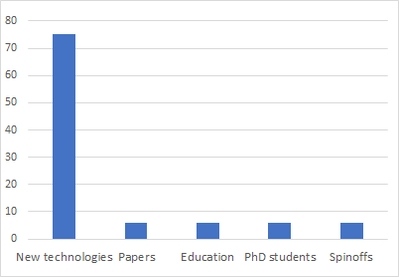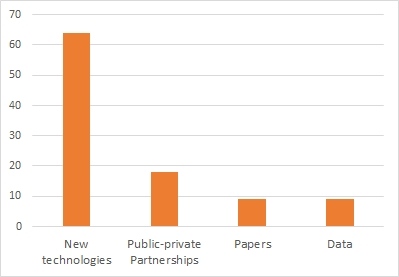The X factor of eXcellent scientists in the Netherlands: relationships between motivation, utilisation and impact
Can excellent science be connected with successful research commercialisation? Top scientists winning prestigious Spinoza and Stevin prizes share some insights. Their ‘X factor’ achievements suggest that institutionalised research commercialisation can benefit from more personalised pathways.
Excellent science
Achieving scientific success depends on several factors: inspiration, creativity, hard work, access to the most advance instruments, et cetera. In the scholarly literature, excellent output of scientists has been described as a resultant of several factors with complex and often unpredictable interactions between personal characteristics such as education, personality, motivation, ambition with a mix of environmental factors [see 1, 2, 3, 4 ].
But chance is also one of these determinants. Only a small minority of ‘lucky’ scientists discover something really new and worthwhile, with exciting insights and prospects for their fellow researchers to further unravel. An even smaller number of researchers produce ‘once in a lifetime’ scientific breakthroughs that generate major impacts on contemporary science, societies and economies. Think ‘Albert Einstein’ or, perhaps more appropriate at these special times, the developers of the radically new production platforms for Covid-19 vaccines.
Science celebrates its top scientists. And funders will keep supporting such excellence, as long as the general public, politicians and governments are convinced that scientific research is also a worthwhile effort for all of us. But during the last two decades stakeholders have become increasingly concerned and pose some fundamental questions: is science doing enough to tackle and solve the numerous societal, environmental and economic problems that affect mankind? Think for example about global climate change, human and animal health and welfare, poverty reduction, emigration… and again the Covid-19 pandemic. Pressure seems to be mounting to provide scientific results, especially of academic research, more useful for societal applications and the economy.
Research commercialisation and knowledge transfer
The Netherlands has been one of many countries in the European Union to adopt policies to move universities out of their ‘Ivory Towers’ and commercialise scientific research results faster and more effective. In 2004 research commercialisation officially became the third mission of universities in the Netherlands (along with education and scientific research). In the year 2000 the Dutch government also implemented three funding instruments (BioPartner, TechnoPartner, Programma Valorisatie) to also optimise ‘technology transfer’ between universities and industry. Gradually, since the 1980s, most universities in the Netherlands have established specialised units – either within the organisation or decentralised – for knowledge transfer and research commercialisation. Here, we will refer to these organisational units as ‘Knowledge and Transfer Offices’ (KTOs). The organisational set-up and goals of these units vary across universities.
These policy shifts had a major impact on the scientific work force. During the last two decades individual researchers and engineers in the Netherlands have increasingly been stimulated by government policies and other incentives to develop scientific and technological breakthroughs that can contribute to solve societal problems or create economic benefits [see 7, 8, 9]. One of the prime incentives is the Stevin prize, issued annually since 2018 by the Netherlands Council for Scientific Research (NWO). The award, a whopping 2.5 million euro, should be spent on research or other activities aimed at knowledge utilisation. The Stevin prize has been awarded to 32 scientists since 1998. Knowledge exploitation and utilisation, including venturing spin-off companies, is a criterion for Stevin prize nominees since 2001. Recently, concerns have been raised in the Netherlands that striving for research excellence may actually reduce the capacity of researchers to engage with societal issues.
Survey and respondents
Our survey aimed to gather information from these award-winning scientists on the relationships between excellent science, research commercialisation and knowledge utilisation (none of the respondents was informed that we had invited them due to their status as top scientist). We were particularly interested in their motives to engage in utilisation, and their views on how their research achievements were able to create such an external impact. This survey builds on our earlier study that also dealt with motivational factors underpinning research commercialisation activities but framed in the context of intellectual property regimes.
We applied a mixed-methods approach with a questionnaire and a series of follow-up interviews. The questionnaire collected information on the disciplinary background of the respondents, their main motivation to conduct research, and information on how they used results of their research efforts to create societal impacts. Follow-up interviews were conducted with a subsample of the respondents. Information gathering took place between September 2019 and March 2020.
The questionnaire was not only sent to all 32 Stevin prize winners but also to those who were awarded the Spinoza prize (the Dutch equivalent of the Nobel Prize), currently worth 2.5 million euros. Between 1995 and 2020 the Spinoza prize has been awarded to 99 scientists for excellent and breakthrough scientific research in their discipline. Our study involved a subgroup of 25 who agreed to participate; 17 Spinoza laureates and 8 Stevin laureates. These Spinoza prize winners worked in natural science (29%), engineering sciences (29%), life and medical sciences (24%), or social and human sciences (18%). Most of those who won a Stevin prize work(ed) in engineering sciences (75%); the remainder in the life and medical sciences (12%) or social and human sciences (12%).
Motives for doing research
Figure 1a shows the percentage of Spinoza laureate respondents who are mainly motivated to do ‘basic research’ (i.e. ‘discovery oriented’ research without any intention to seek immediate applications) as opposed to those who are also driven by the wish to apply their research results and perhaps commercialize it. Next to their scientific motivations, the majority of Spinoza respondents fully agree that ‘to obtain scientific insight on topics in their discipline’ is the most important personal motivation to do research, followed by ‘looking for applications of my research results’ and ‘recognition for my scientific achievements’. The vast majority of Spinoza prize respondents (82%) are of the opinion that research commercialisation policies should not be the guiding principle for scientists in general. Interestingly, 94% of these Spinoza laureates has nonetheless been actively engaged with some degree of research commercialisation. A fair share of them have been involved in creating spin-off companies, patent licensing, clinical trials, or dissemination of research data via websites or personal twitter accounts (together 33%). Others have been involved in business consultancy for companies (19%), training (16%), presentation for a general public (16%), or joint research or contract research with companies (13%). Almost half of all these respondents (47%) used the services offered by the KTO at their university or university medical centre.
(a) Spinoza prize laureates

(b) Stevin prize laureates

Figure 1. Main motivation for basic research (% of respondent answers)
The Stevin prize winners present a markedly different profile. As figure 1b shows, none of them are motivated to conduct basic research without some notion of immediate applications in mind. However, 62% still acknowledge that ‘to obtain scientific insight on topics in their discipline’ is the most important personal motive to do research, followed by ‘looking for applications of my research results’ and ‘recognition for my scientific achievements’. More than a third of these respondents (38%) indicate that ‘research commercialisation policies should be the guiding principle for scientists in their research, 25% found that ‘research commercialisation policies should at least partially guide scientists in their research’. The majority of all Stevin respondents (88%) has been actively engaged in several pathways to commercialise research findings - mostly through joint research or contract research with industry (35%) and/or business consultancy (20%). All of the Stevin respondents acknowledged their use of KTO services.
Knowledge utilisation and impact profiles
The scientific results of Spinoza prize winners were disseminated and utilised through a wide range of channels: published research papers (25%), through work of PhD students (22%), but also as contributions to public private partnerships with industry (14%), education (10%), scientific books (10%), patents (8%), or patient care (5%). Stevin prize laureates show a fairly similar distribution: published research papers (19%), PhD students (16%), public private partnerships with industry (16%), for education (12%), patents (12%), spin-off companies (9%), scientific books (6%), other innovations in education and research (6%), or patient care (3%).
Both groups show slightly different impact profiles. Queried about the channels in which their research really made a significant external impact, the category ‘new technologies’ is by far the most important channel of utilisation within the group of Spinoza prize winners (figure 2a). As confirmed by the data in last paragraph, KTOs play a key role in this channel featuring very prominently among the Stevin prize laureates (figure 2b).But, interestingly, both the Spinoza and Stevin laureates mention several other non-KTO channels, such as research publications, PhD students, and data dissemination.
(a) Spinoza prize laureates

(b) Stevin prize laureates

Figure 2. External impact channels (% of total responses)
Final reflections
This exploratory study captures experiences and personal views of 25 prize-winning scientists in the Netherlands. The information from our survey indicates that their personal motives and drive to conduct breakthrough science (summarised here as their ‘X factor’) can be an important factor for researchers to engage with research commercialisation and knowledge utilisation – in some cases perhaps even more relevant than government policies or institutional facilities such as university KTOs. Obviously, more information has to be collected, across a larger group of top scientists, before robust conclusions can be drawn. Nevertheless, our first findings suggest that if current policies and incentives were to be reviewed, it could be beneficial to incorporate views of prize-winning scientists with a track record in research commercialisation and knowledge transfer. Their input to our survey highlights that more personalised approaches may offer supplementary incentives, in addition to KTO services and other institutionalised pathways in the Netherlands, to excel in the societal or economic utilisation of research.




0 Comments
Add a comment